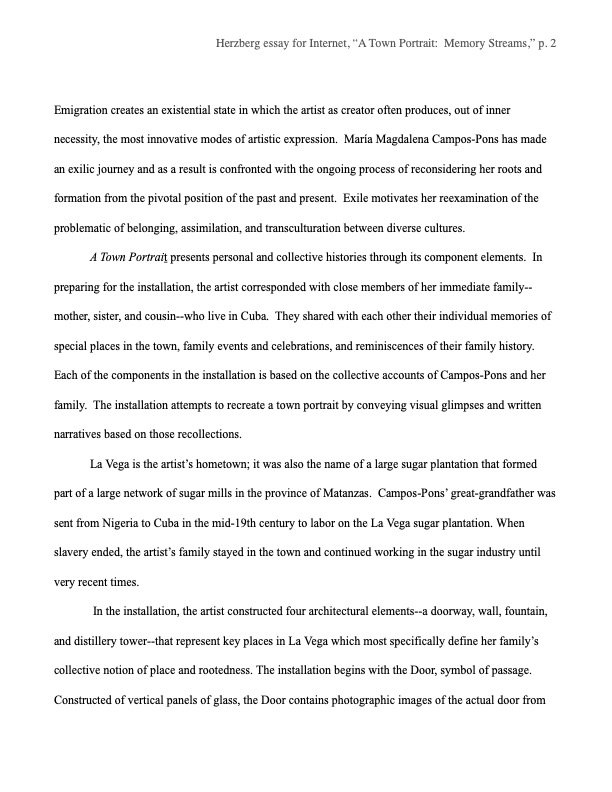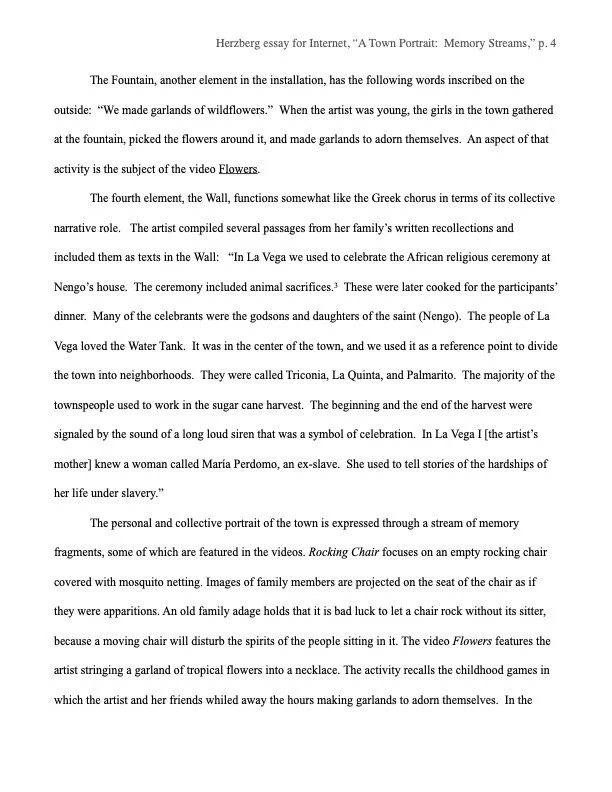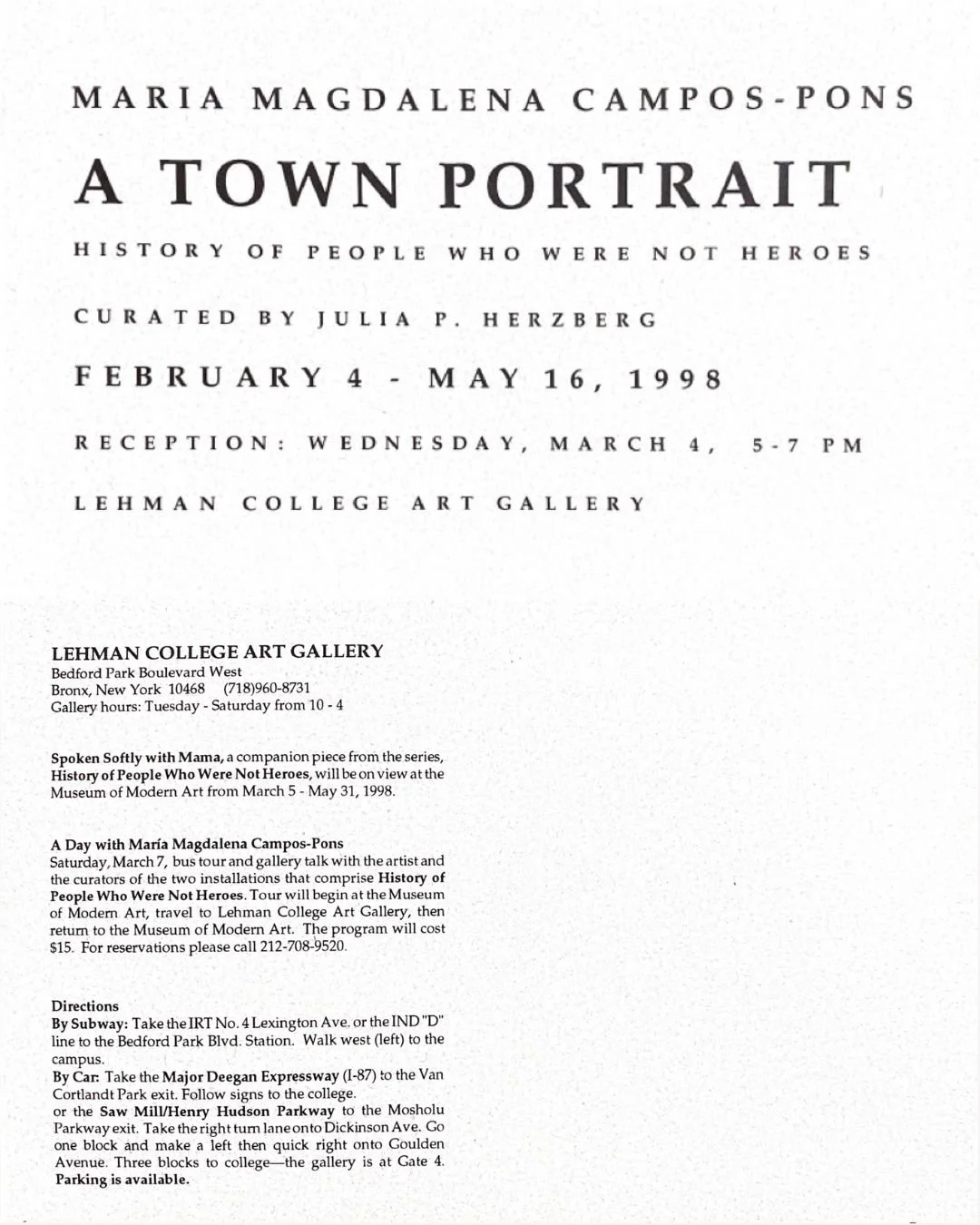María Magdalena Campos-Pons: A Town Portrait
Essay and Wall Texts by Julia P. Herzberg, Guest Curator
1998, Curator Julia P. Herzberg, Magdalena Campos–Pons, History of People That Were Not Heroes: Part I, A Town Portrait. Organized by Lehman College Art Gallery/CUNY, Bronx, New York (Mar.-May 1998). http://www.lehman.cuny.edu/vpadvance/artgallery/gallery/campospons/TextTower.html. No image may be copied from this essay without the permission of the artist©. All images ©Maria Magdalena Campos-Pons. All additional information herein printed as it was in 1998.
María Magdalena Campos-Pons (Cuba, 1959; Boston, 1991 to present). A Town Portrait, 1994 Installation, four sculptures (clay, steel, blown and fused glass, copper) and three video projections with sound: Rocking Chair, Flowers, Water Images. Dimensions variable according to space. Collection of the artist
María Magdalena Campos-Pons (Cuba, 1959; Boston, 1991 to present). (Detail) A Town Portrait, 1994 Installation, four sculptures (clay, steel, blown and fused glass, copper) and three video projections with sound: Rocking Chair, Flowers, Water Images. Dimensions variable according to space. Collection of the artist
María Magdalena Campos-Pons (Cuba, 1959; Boston, 1991 to present) Abridor de caminos, 1997. Ten Polaroid prints, each 29 x 22 inches Courtesy of Mario Diacona Gallery, Boston The artist’s use of the Polaroid 20 x 24 camera was funded by Polaroid Artist Support Program.
María Magdalena Campos-Pons (Cuba, 1959; Boston, 1991 to present) When I Am Not Here/ Estoy allá, 1996 Three Polaroid prints, each 29 x 22 inches Collection of Martha Schneider, Chicago
INTRODUCTORY WALL PANEL
María Magdalena Campos-Pons was born and raised in Cuba. The artist was trained in Havana at the National School of Art, the Superior Institute of Art (ISA), and Massachusetts College of Art. She has lived and worked in Boston since arriving in the United States in 1991 and has exhibited extensively in this country and Canada. In 1993 she was a recipient of the Bunting Fellowship, Mary Ingraham Bunting Institute, Radcliffe Research and Study Center, in Cambridge, Massachusetts, and completed this project during the fellowship year. Most recently Campos-Pons was one of the artists selected for the 1997 Johannesburg Biennial.
A Town Portrait, 1994, is an installation with sculptural objects and three video projections with sound. It is the first of the three-part series History of People Who Were Not Heroes: Growing Up in a Slave Barracks. The installation is a visualization of the artist’s memories of her childhood home in La Vega, a 19th-century sugar plantation in the province of Matanzas, Cuba. The roots of the artist’s family go back to the slave-trading era when her great-grandfather from Nigeria worked on the plantation. After slavery, his children and their families continued working in the sugar industry until recently. Campos-Pons lived in La Vega until she was twelve, then left for the city of Matanzas to study art. Her project attempts to recall aspects of personal histories through the recollections of Campos-Pons’ mother, sisters, and cousins, creating a micro-history from personal testimonies of relatives, who still live in the area of La Vega.
Memory is fleeting, fragile, and fragmentary; it returns in glimpses. To recall a place, to fill in the spaces between then and now, here and there, the artist created an installation with four sculptural objects and three performances. In La Vega, each of those structures--a doorway, wall, fountain, and distillery tower--demarcated a special place for the townspeople. Campos-Pons collected stories from her family and inscribed their words--together with hers--on the sculptural objects. The narratives alternately describe the artist’s trips to and from the town, her childhood games, her family’s celebrations and rituals. Archival and contemporary photographic images set in the Door provide glimpses of family and town life, some of which include the doorway to her former home in an old slave barrack.
The personal and collective portrait of the town is expressed through a stream of memory fragments, some of which are featured in the videos. One video focuses on an empty rocking chair covered with mosquito netting. Images of family members are projected on the seat of the chair as if they were apparitions. An old family adage holds that it is bad luck to let a chair rock without its sitter, because a moving chair will disturb the spirits of the people sitting in it. Another video features the artist stringing a garland of tropical flowers into a necklace. The activity recalls the childhood games in which the artist and her friends whiled away the hours making garlands to adorn themselves. In the third video, the artist sifts water through her hands from an aluminum casserole. Images of tropical trees appear in her palms as she evokes the ephemeral nature of re-collecting. The performances are accompanied by Campos-Pons’ childhood lullaby, sung softly, slowly, and rhythmically, adding another layer to the personal narrative of a Town Portrait.
The artist’s excavations of childhood memories result from her living in the United States, away from Cuba. Negotiating her place between the here and now, and the there and then is an ongoing process, expressed and performed in diverse artistic forms in this exhibition at the Lehman College Art Gallery.
EXTENDED WALL TEXTS
Abridor de caminos
Abridor de caminos is one of two series of photographs addressing the artist’s ongoing explorations of personal and collective history, identity, gender, and religion. The photographs, produced in the mind and performed by the body, are linked to the videos in A Town Portrait. Part of a larger corpus of photography executed during the previous year, they expand the media for which the artist has become known, namely sculptural objects, installations, video, and performance.
Abridor de caminos features ten different shots, many of which are of the artist as subject and object of the performance. Aspects of her Yoruba-derived, Santería background are drawn for images, colors, and meaning. Red and black are the colors of Elegguá, the deity that opens one’s path, abridor de caminos. References to African sculpture are implicit in, for example, the shot of the artist’s legs, lined with red, referring to scarification; her hair is elaborately coiffed with beads--evoking the intricate hairstyles that convey status and gender in traditional African art. The body--viewed close up and in fragments--performs minimal gestures, an accumulation of which imparts the monumental presence of tradition, survival, continuity, innovation, and creativity.
When I Am Not Here/ Estoy alla
In When I Am Not Here/ Estoy alla, Campos-Pons is covered in brown and white makeup. Two of the three photographs feature the artist with English and Spanish texts written across her chest. The work problematizes the complex issues confronting the artist who has moved from one country to another at a time when travel between them is restricted. From the artist’s vantage point, “here” and “there (alla)” are transmutable. In her performance, the artist (re)identifies her existential state as she (re)negotiates her notion of place. The phrases on the artist’s chest, “IDENTITY COULD BE A TRAGEDY” and “PATRIA UNA TRAMPA” (Homeland [is] an Entrapment), may be interpreted in light of the charged views espoused by either U.S. or Cuban cold war politics, or in light of artist’s personal politics: the need to go beyond the restrictions imposed by nations, whether or not at political odds.
1998, Curator Julia P. Herzberg, Magdalena Campos–Pons, History of People That Were Not Heroes: Part I, A Town Portrait. Organized by Lehman College Art Gallery/CUNY, Bronx, New York (Mar.-May 1998). http://www.lehman.cuny.edu/vpadvance/artgallery/gallery/campospons/TextTower.html.










